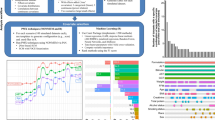Summary
In this work we establish the basic layout of IONICS, an expert system for optimizing the separation of ionogenic solutes in Reversed-Phase Liquid Chromatography, using the pH and the organic-modifier concentration of the mobile phase as parameters. We also present REMO, a front-end system that automates the retention modelling stage, based on a 9-parameter model. This system uses a scale transformation to suppress several numerical problems previously observed and features a strategy for automatic calculation of an initial approximation to the model optimum. The successful application of this system to a set of seven drugs is described. The final models are accurate and have smaller numerical problems. We also describe the use of a genetic algorithm instead of classical non-linear least-squares for fitting the model to the experimental data. Results indicate that genetic algorithms are a valuable, complementary tool for retention modelling.
Similar content being viewed by others
Abbreviations
- Φ:
-
constant that, for an experimental design with three equally spaced levels of organic-modifier content, is the value of the middle level.
- ε:
-
constant that, for an experimental design with three equally spaced levels of organic-modifier content, is the reciprocal of the difference between two successive levels.
- ϕ:
-
fraction of organic modifier in the mobile phase
- ϕ:
-
rescaled fraction of organic-modifier content of the mobile phase. For a given experimental design with three equally spaced levels of organic-modifier content, ϕ takes the values −1, 0 and +1 at the minimum, central, and maximum levels.
- GA:
-
genetic algorithm (an optimization algorithm based on special operators that mimic evolutionary techniques)
- k:
-
observed capacity factor
- k0 :
-
capacity factor of neutral species
- k 00 :
-
capacity factor of neutral species in pure water
- k Φ0 :
-
capacity factor of neutral species in a water/organic-modifier mixture, with 100 Φ% organic-modifier
- k−1 :
-
capacity factor of negatively charged species
- k 0−1 :
-
capacity factor of negatively charged species in pure water
- k Φ−1 :
-
capacity factor of negatively charged species in a water/organic-modifier mixture, with 100 Φ% organic-modifier
- k1 :
-
capacity factor of positively charged species
- K 0a :
-
acidity constant of a monoprotic acid HA in pure water
- N:
-
neutral solute
- NLLS:
-
non-linear least-squares optimization algorithm
- Q1, Q2 :
-
second and third coefficients, respectively, of a polynomial model for ln Ka as a function of the fraction of organic modifier (constant pH)
- Q Φ1 , Q Φ2 :
-
second and third coefficients, respectively, of a polynomial model for ln Ka as a function of ϕ, the rescaled fraction of organic modifier (constant pH)
- rp :
-
degree of ionization of a solute at a pH value of p
- SA:
-
strongly acidic solute
- SB:
-
strongly basic solute
- Si :
-
second coefficient of a polynomial model for ln ki as a function of the fraction of organic modifier (constant pH)
- S Φi :
-
second coefficient of a polynomial model for ln ki as a function of ϕ, the rescaled fraction of organic modifier (constant pH)
- SSQ:
-
sum of squares of the differences between calculated and observed values.
- Ti :
-
third coefficient of a polynomial model for ln ki as a function of the fraction of organic modifier (constant pH)
- T Φi :
-
third coefficient of a polynomial model for ln ki as a function of ϕ, the rescaled fraction of organic modifier (constant pH)
- t0 :
-
hold-up time
- WA:
-
weakly acidic solute
- WB:
-
weakly basic solute
References
P. J. Schoenmakers, Optimization of Chromatographic Selectivity. A Guide to Method Development, Elsevier, Amsterdam, 1986.
L. R. Snyder, J. L. Glajch, J. J. Kirkland, Practical HPLC Method Development, Wiley, New York, 1988.
R. M. Lopes Marques, P. J. Schoenmakers, J. Chromatogr.,592, 157 (1992).
P. J. Schoenmakers, S. v. Molle, C. M. G. Hayes, L. G. M. Uunk, Anal. Chim. Acta,250, 1 (1991).
P. J. Schoenmakers, N. Mackie, R. M. Lopes Marques, Optimizing Separations in Reversed-Phase Liquid Chromatography, Chromatographia (1992) in print.
J. C. Berridge, Chemometrics & Intell. Lab. Syst.,3, 175 (1988).
C. K. Bayne, I. B. Rubin, Practical Experimental Designs and Optimization Methods for Chemists, VCH Publishers, Deerfield Beach, Florida, 1986.
G. K. C. Low, A. Bartha, H. A. H. Billiet, L. de Galan, J. Chromatogr.,478, 21 (1989).
P. J. Schoenmakers, H. A. H. Billiet, L. de Galan, J. Chromatogr.,205, 13 (1981).
H. A. H. Billiet, L. de Galan, J. Chromatogr.,485, 27 (1989).
D. E. Goldberg, Genetic Algorithms in Search, Optimization and Machine Learning, Addison-Wesley, Reading, Massachussets, 1989.
D. H. Ackley, A Connectionist Machine for Genetic Hillclimbing, Kluwer Academic Publishers, Norwell, Massachussets, 1987.
D. E. Rumelhart, J. L. McClelland, Parallel distributed processing, MIT, Cambridge, Massachussets, 1986.
C. B. Lucasius, M. J. J. Blommers, L. M. C. Buydens, G. Kateman, A Genetic Algorithm for Conformational Analysis of DNA, in L. Davis, ed., The Handbook of Genetic Algorithms, Van Nostrum-Reinhold, 1991.
C. B. Lucasius, G. Kateman, Applications of Genetic Algorithms in Chemometrics, in J. D. Schaffer, ed., Third Int. Conf. on Genetic Algorithms, Morgan Kaufmann, 1989.
W. H. Press, B. P. Flannery, S. A. Teukolsky, W. T. Vetterling, Numerical Recipes. The Art of Scientific Computing, Cambridge University Press, Cambridge, 1986.
R. M. Lopes Marques, P. J. Schoenmakers, Proc. 13th. Meeting Port. Chem. Soc., Lisbon, Portugal, 1991.
Author information
Authors and Affiliations
Rights and permissions
About this article
Cite this article
Lopes Marques, R.M., Schoenmakers, P.J., Lucasius, C.B. et al. Modelling chromatographic behaviour as a function of pH and solvent composition in RPLC. Chromatographia 36, 83–95 (1993). https://doi.org/10.1007/BF02263843
Received:
Revised:
Accepted:
Issue Date:
DOI: https://doi.org/10.1007/BF02263843




